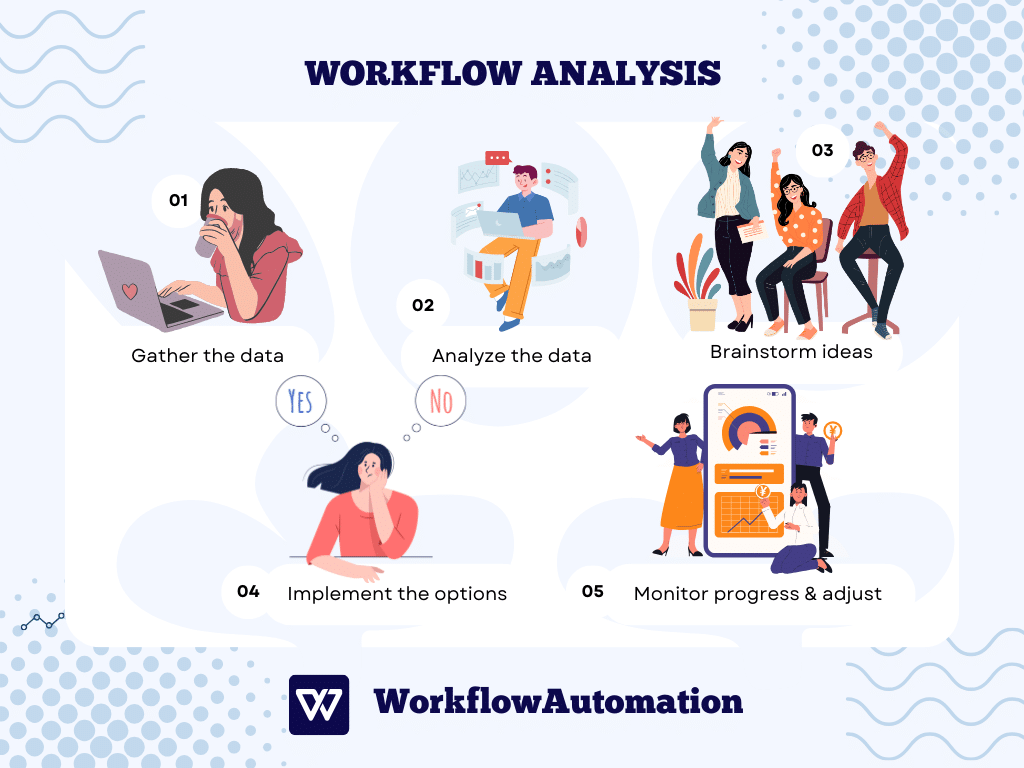Workflow analysis is a way of looking at every step in your workflow process and analyzing it in order to identify opportunities to make things more efficient or eliminate dead weight.
It can be especially useful when you’re trying to improve how people work together on projects, but you can also use it to examine all aspects of your organization’s operations from top to bottom.
The goal of any workflow analysis you start should be to align the result you expect with the actual workflow result.
Let’s see how we can achieve that.
What is Workflow Analysis?
The definition of workflow analysis encompasses all critical processes that involve identifying inefficiencies, bottlenecks, and areas for improvement in a process. The next step is implementing changes to streamline the process and improve overall efficiency.
The process includes gathering and analyzing data, brainstorming ideas, implementing changes, and monitoring progress.
Companies conduct a workflow analysis to make sure their operations run smoothly and efficiently. Several situations require businesses to conduct this process, such as automating workflows, changing the company structure, introducing new technologies, dealing with regulatory changes, and reducing costs.
The workflow analysis process involves stakeholders within the company, and it may involve multiple departments or teams. The analysis involves identifying the process that needs analysis, collecting data on the current process, analyzing the data, brainstorming ideas for improvements, selecting the best solution, implementing the options, and monitoring progress so you can adjust the process accordingly.
Efficient workflows have several characteristics that contribute to their success, including clearly defined roles and responsibilities, effective communication, continuous improvement, and adaptability.
When Should You Conduct Workflow Analysis?
Conducting a workflow analysis can help companies identify inefficiencies, streamline processes, and improve overall efficiency. Additionally, it can help identify potential risks and opportunities for improvement.
Several situations require companies to conduct a workflow analysis, including:
- Automating processes. When a company decides to automate a process, it requires a workflow analysis to identify the current process’s inefficiencies and areas that require automation. Automation can reduce errors, increase speed, and improve the quality of the product or service.
- Transformation within the company. A merger or acquisition can lead to changes in the company’s workflow. Conducting a workflow analysis can help identify the necessary changes and ensure a smooth transition. It can also optimize employee roles and identify potential redundancies or overlaps in the workflow.
- Introduction of new technology. The introduction of new technology can significantly impact a company’s workflow. Companies can conduct a workflow analysis to identify the necessary changes and ensure that the new technology integrates seamlessly into the current workflow. It can also identify potential training needs and ensure employees can effectively use the new technology.
- Changes in regulations. Changes in regulations can impact a company’s workflow. Conducting a workflow analysis can help identify the necessary changes required to comply with the new regulations. It can also identify potential risks and opportunities for improvement.
- Need for cost reduction. When companies need to reduce costs, they should always conduct a workflow analysis first. It can identify areas where you can reduce costs without affecting the quality of the product or service. It can pinpoint potential opportunities to improve efficiency and reduce costs.
The Importance of Workflow Analysis
By analyzing workflows, businesses can regain control over different processes within the company and find opportunities for process improvement. Workflow analysis is occasionally carried out in case it falls short of some important goal or isn’t performing as expected.
By analyzing workflows, companies can identify areas for improvement, optimize their processes, and improve the overall quality of their business.
Workflow analysis is often preventative and proactive for your business. The advantages of a good workflow analysis can include:
#1. Higher Productivity
Workflow analysis helps companies optimize their workflows, identify bottlenecks and inefficiencies, and improve productivity. By analyzing workflows, companies can identify areas where improvement will have the most significant impact and implement changes to improve productivity.
#2. Less Ambiguity
Defining workflows reduces ambiguity, ensures that everyone understands their roles and responsibilities, and avoids misunderstandings. By analyzing workflows, companies can easily identify areas where processes are unclear and clarify them for employees.
#3. Identification of Issues
With workflow analysis, companies can identify potential problems before they become significant issues, allowing them to take corrective action immediately. This can help impact the productivity or quality of the business.
#4. Better collaboration
Workflow analysis promotes collaboration among team members, helping them work together to identify inefficiencies, streamline processes, and improve productivity. By analyzing your company’s workflow, you can identify areas where collaboration can have a more significant impact and encourage teamwork among colleagues.
Types of Workflow Analysis
Workflow analysis can be conducted using different approaches, depending on the company’s needs and goals.
Here are three common types of workflow analysis:
#1. Linear Workflow Analysis
This type of workflow analysis is a step-by-step evaluation of the process, where each step follows the previous one with little or no variation. It’s a straightforward and structured approach to workflow analysis. Linear workflow analysis is useful in identifying process inefficiencies and redundancies.
It allows organizations to create a visual representation of the process that everyone can easily understand and communicate across the organization. For example, a manufacturing company might use linear workflow analysis to identify where they could reduce production time or eliminate waste.
#2. Cross-Functional Workflow Analysis
This type of workflow analysis represents an evaluation of the process, where different functional areas within the organization work together to identify redundancies, bottlenecks, and inefficient work. This approach is useful in identifying handoffs between different departments, which can cause delays and waste of either time or resources.
Cross-functional workflow analysis encourages collaboration and communication between different teams, which can lead to better process design and improvements. For example, a healthcare provider might use this technique to identify areas where patient information isn’t being shared effectively between different departments, leading to delays in treatment.
#3. Hybrid Workflow Analysis
This is a combination of linear and cross-functional. It involves evaluating the process from a step-by-step perspective and identifying handoffs between different departments. Hybrid workflow analysis combines the best of the previous two, leading to better process design and improvements.
For example, a financial institution might use hybrid workflow analysis to locate areas where they can reduce loan processing time. This means handoffs between different departments can be made efficiently and proactively.
How to Know if Workflow is Efficient
Efficient workflows have several characteristics that contribute to their success.
These include:
- Clearly defined roles and responsibilities. In an efficient workflow, everyone knows what their responsibilities are and can work independently. This avoids bottlenecks and delays in the process. It makes sure everyone is working towards the same goal.
- Process automation. Automation can significantly improve workflow efficiency by reducing errors, increasing speed, and improving the quality of the product or service. It can identify areas where automation is feasible and implement automation to reduce manual labor and save time.
- Effective communication. In an efficient workflow, communication is clear and timely. A team member should be able to communicate with each other easily, whether in person or through technology, and provide feedback and support when somebody needs it.
- Continuous improvement. Having an efficient workflow means you’re continually reviewing and improving it. By analyzing it regularly, companies can identify opportunities for improvement and implement changes to streamline processes and improve productivity.
- Adaptability. A good workflow is adaptable to changes in the market, technology, and regulations. It can quickly respond to changes and ensure that the process remains relevant and up-to-date.
How to Conduct Workflow Analysis
Workflow analysis can be applied to many different kinds of projects, including business processes, software development cycles, and even time management strategies. The key is knowing how each part fits together. This way, you’ll know where to look for solutions if something goes wrong.
The following are the most important steps in workflow analysis:
#1. Gather The Data
The first step in any workflow analysis is to gather data. Identify the process that you should analyze and everyone that it involves. Collect data on the current process, including process maps, standard operating procedures, and performance metrics.
You can collect this data through observation, interviews, surveys, or a combination of these methods. It’s essential to identify bottlenecks, inefficiencies, and areas for improvement in the current process.
#2. Analyze The Data
You’ll need to analyze the data to find out where the bottlenecks are. The process includes identifying patterns, trends, and the root causes of inefficiencies.
You can do this by looking at how long it takes for each step of your workflow to be completed. You can also try counting how many times each step is done. Find out what is causing these bottlenecks and determine if there are ways to fix them.
This step is crucial in identifying areas where you can use automation or technology to improve the process. Data analysis can be done using various tools such as flowcharts, Pareto charts, histograms, and scatter diagrams.
Analyze the data again after making changes to see if they have improved things or made them worse. Bear in mind that this could take some time, and don’t be discouraged; trust the process.
#3. Brainstorm Ideas
To brainstorm, you will need to think about what you’re trying to accomplish—your main goal. Brainstorm as many different ways of accomplishing this goal as possible. Evaluate each idea based on its feasibility and other factors like cost, time frame, etc.
#4. Implement The Options
After choosing the best solution, the next step is to implement the chosen option. This step involves developing a plan for implementing the changes, including timelines, responsibilities, and resources required. Communication is essential during this stage, and you should inform all stakeholders of the changes and provide them with training if necessary.
You should execute the plan with precision and address any issues immediately to ensure a smooth transition.
#5. Monitor Progress & Adjust
The final step in conducting a workflow analysis is to monitor progress and adjust the process accordingly. After implementing the changes, it is essential to monitor the process to ensure that it is working effectively.
Collect data on the new process and compare it to the data collected before the changes were made. Identify any new bottlenecks or inefficiencies, and adjust the process as needed.
Continuous improvement is essential to maintaining an efficient workflow, and you should make adjustments as necessary to ensure optimal results.
Conclusion
Workflow analysis is a crucial practice for organizations whose goal is to enhance their efficiency, productivity, and service/product quality. The process helps in identifying any bottlenecks and provides you with information on what areas could be improved.
This leads to better decision-making, streamlined processes, and continuous progress. By following the process step-by-step, businesses can carry out an effective workflow analysis and implement changes that will improve the overall success of their organization.








